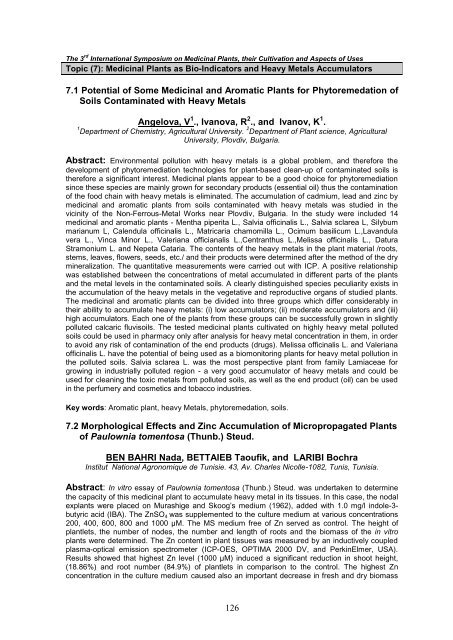Abstract Book - 3rd International Symposium on Medicinal Plants ...
Abstract Book - 3rd International Symposium on Medicinal Plants ...
Abstract Book - 3rd International Symposium on Medicinal Plants ...
You also want an ePaper? Increase the reach of your titles
YUMPU automatically turns print PDFs into web optimized ePapers that Google loves.
The 3 rd <str<strong>on</strong>g>Internati<strong>on</strong>al</str<strong>on</strong>g> <str<strong>on</strong>g>Symposium</str<strong>on</strong>g> <strong>on</strong> <strong>Medicinal</strong> <strong>Plants</strong>, their Cultivati<strong>on</strong> and Aspects of Uses<br />
Topic (7): <strong>Medicinal</strong> <strong>Plants</strong> as Bio-Indicators and Heavy Metals Accumulators<br />
7.1 Potential of Some <strong>Medicinal</strong> and Aromatic <strong>Plants</strong> for Phytoremedati<strong>on</strong> of<br />
Soils C<strong>on</strong>taminated with Heavy Metals<br />
Angelova, V 1 ., Ivanova, R 2 ., and Ivanov, K 1 .<br />
1 Department of Chemistry, Agricultural University. 2 Department of Plant science, Agricultural<br />
University, Plovdiv, Bulgaria.<br />
<str<strong>on</strong>g>Abstract</str<strong>on</strong>g>: Envir<strong>on</strong>mental polluti<strong>on</strong> with heavy metals is a global problem, and therefore the<br />
development of phytoremediati<strong>on</strong> technologies for plant-based clean-up of c<strong>on</strong>taminated soils is<br />
therefore a significant interest. <strong>Medicinal</strong> plants appear to be a good choice for phytoremediati<strong>on</strong><br />
since these species are mainly grown for sec<strong>on</strong>dary products (essential oil) thus the c<strong>on</strong>taminati<strong>on</strong><br />
of the food chain with heavy metals is eliminated. The accumulati<strong>on</strong> of cadmium, lead and zinc by<br />
medicinal and aromatic plants from soils c<strong>on</strong>taminated with heavy metals was studied in the<br />
vicinity of the N<strong>on</strong>-Ferrous-Metal Works near Plovdiv, Bulgaria. In the study were included 14<br />
medicinal and aromatic plants - Mentha piperita L., Salvia officinalis L., Salvia sclarea L, Silybum<br />
marianum L, Calendula officinalis L., Matricaria chamomilla L., Ocimum basilicum L.,Lavandula<br />
vera L., Vinca Minor L., Valeriana officianalis L.,Centranthus L.,Melissa officinalis L., Datura<br />
Stram<strong>on</strong>ium L. and Nepeta Cataria. The c<strong>on</strong>tents of the heavy metals in the plant material /roots,<br />
stems, leaves, flowers, seeds, etc./ and their products were determined after the method of the dry<br />
mineralizati<strong>on</strong>. The quantitative measurements were carried out with ICP. A positive relati<strong>on</strong>ship<br />
was established between the c<strong>on</strong>centrati<strong>on</strong>s of metal accumulated in different parts of the plants<br />
and the metal levels in the c<strong>on</strong>taminated soils. A clearly distinguished species peculiarity exists in<br />
the accumulati<strong>on</strong> of the heavy metals in the vegetative and reproductive organs of studied plants.<br />
The medicinal and aromatic plants can be divided into three groups which differ c<strong>on</strong>siderably in<br />
their ability to accumulate heavy metals: (i) low accumulators; (ii) moderate accumulators and (iii)<br />
high accumulators. Each <strong>on</strong>e of the plants from these groups can be successfully grown in slightly<br />
polluted calcaric fluvisoils. The tested medicinal plants cultivated <strong>on</strong> highly heavy metal polluted<br />
soils could be used in pharmacy <strong>on</strong>ly after analysis for heavy metal c<strong>on</strong>centrati<strong>on</strong> in them, in order<br />
to avoid any risk of c<strong>on</strong>taminati<strong>on</strong> of the end products (drugs). Melissa officinalis L. and Valeriana<br />
officinalis L. have the potential of being used as a biom<strong>on</strong>itoring plants for heavy metal polluti<strong>on</strong> in<br />
the polluted soils. Salvia sclarea L. was the most perspective plant from family Lamiaceae for<br />
growing in industrially polluted regi<strong>on</strong> - a very good accumulator of heavy metals and could be<br />
used for cleaning the toxic metals from polluted soils, as well as the end product (oil) can be used<br />
in the perfumery and cosmetics and tobacco industries.<br />
Key words: Aromatic plant, heavy Metals, phytoremedati<strong>on</strong>, soils.<br />
7.2 Morphological Effects and Zinc Accumulati<strong>on</strong> of Micropropagated <strong>Plants</strong><br />
of Paulownia tomentosa (Thunb.) Steud.<br />
BEN BAHRI Nada, BETTAIEB Taoufik, and LARIBI Bochra<br />
Institut Nati<strong>on</strong>al Agr<strong>on</strong>omique de Tunisie. 43, Av. Charles Nicolle-1082, Tunis, Tunisia.<br />
<str<strong>on</strong>g>Abstract</str<strong>on</strong>g>: In vitro essay of Paulownia tomentosa (Thunb.) Steud. was undertaken to determine<br />
the capacity of this medicinal plant to accumulate heavy metal in its tissues. In this case, the nodal<br />
explants were placed <strong>on</strong> Murashige and Skoog‟s medium (1962), added with 1.0 mg/l indole-3-<br />
butyric acid (IBA). The ZnSO 4 was supplemented to the culture medium at various c<strong>on</strong>centrati<strong>on</strong>s<br />
200, 400, 600, 800 and 1000 µM. The MS medium free of Zn served as c<strong>on</strong>trol. The height of<br />
plantlets, the number of nodes, the number and length of roots and the biomass of the in vitro<br />
plants were determined. The Zn c<strong>on</strong>tent in plant tissues was measured by an inductively coupled<br />
plasma-optical emissi<strong>on</strong> spectrometer (ICP-OES, OPTIMA 2000 DV, and PerkinElmer, USA).<br />
Results showed that highest Zn level (1000 µM) induced a significant reducti<strong>on</strong> in shoot height,<br />
(18.86%) and root number (84.9%) of plantlets in comparis<strong>on</strong> to the c<strong>on</strong>trol. The highest Zn<br />
c<strong>on</strong>centrati<strong>on</strong> in the culture medium caused also an important decrease in fresh and dry biomass<br />
126

















